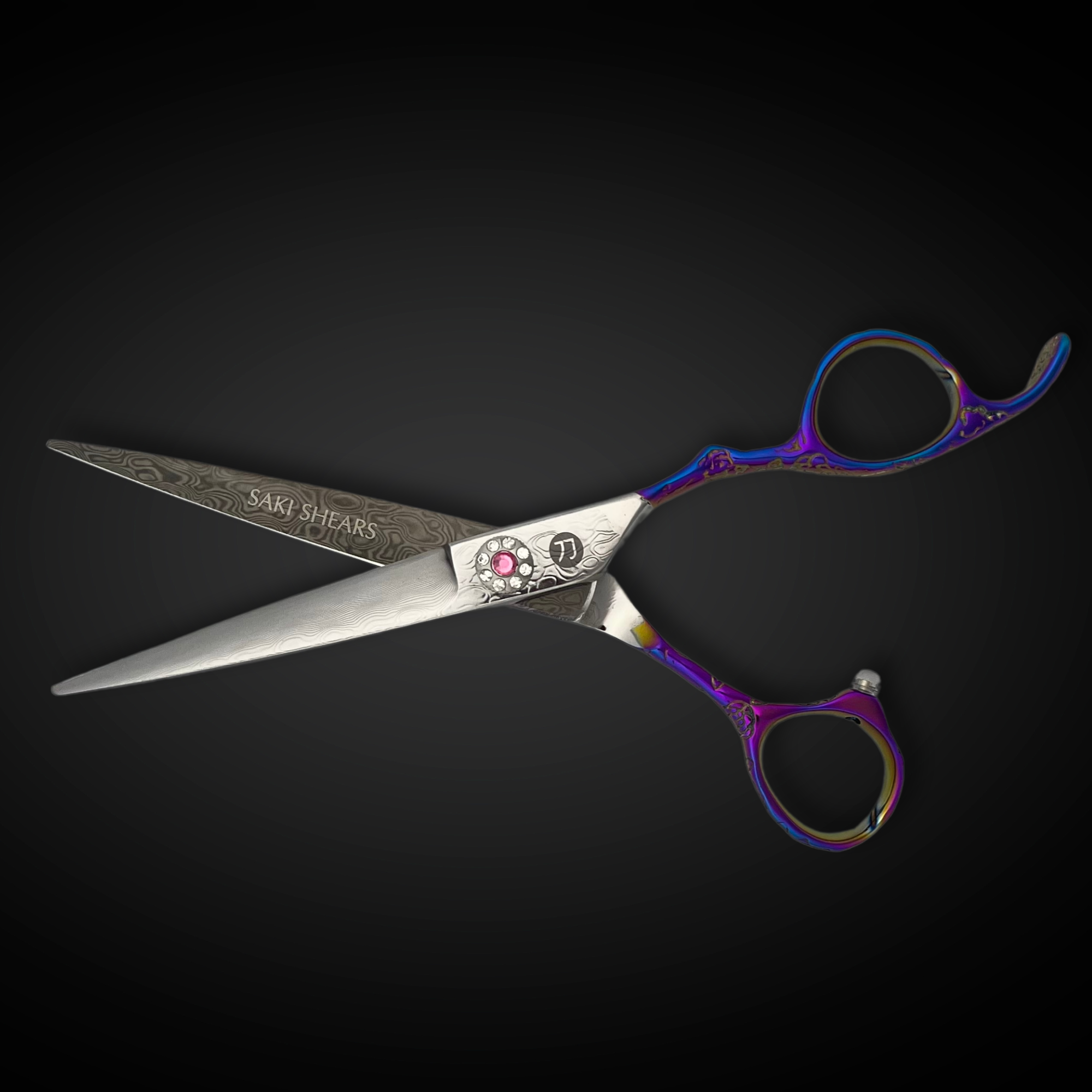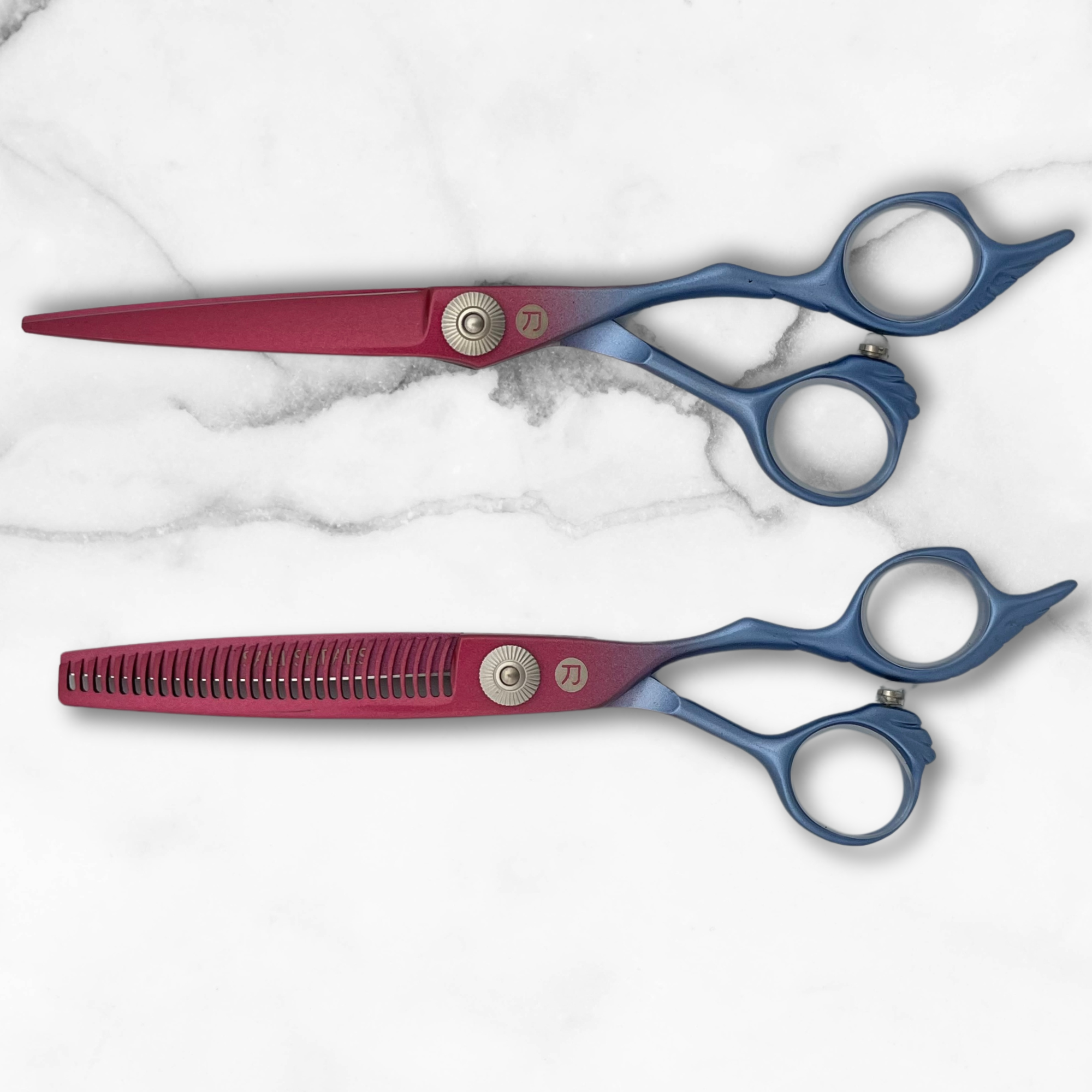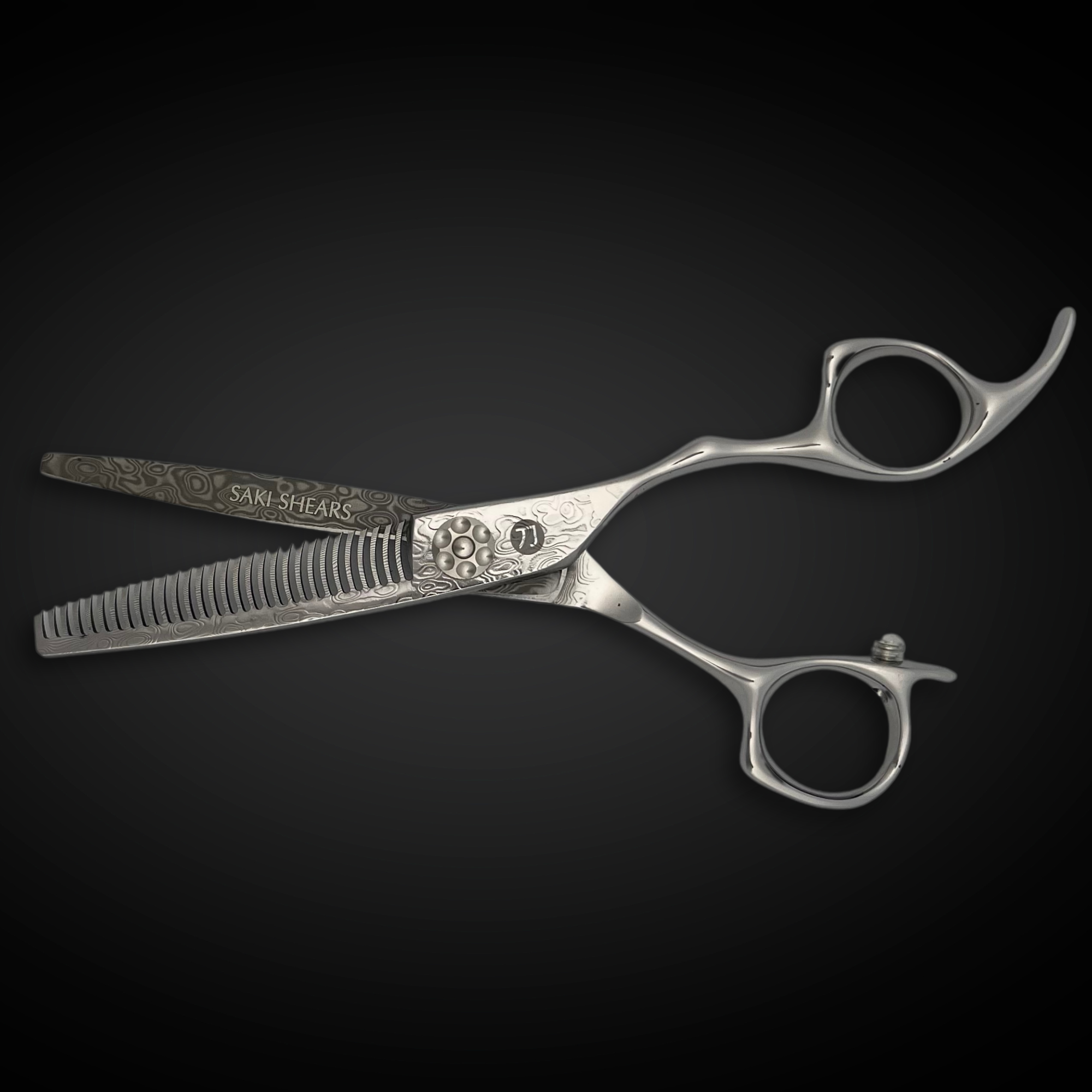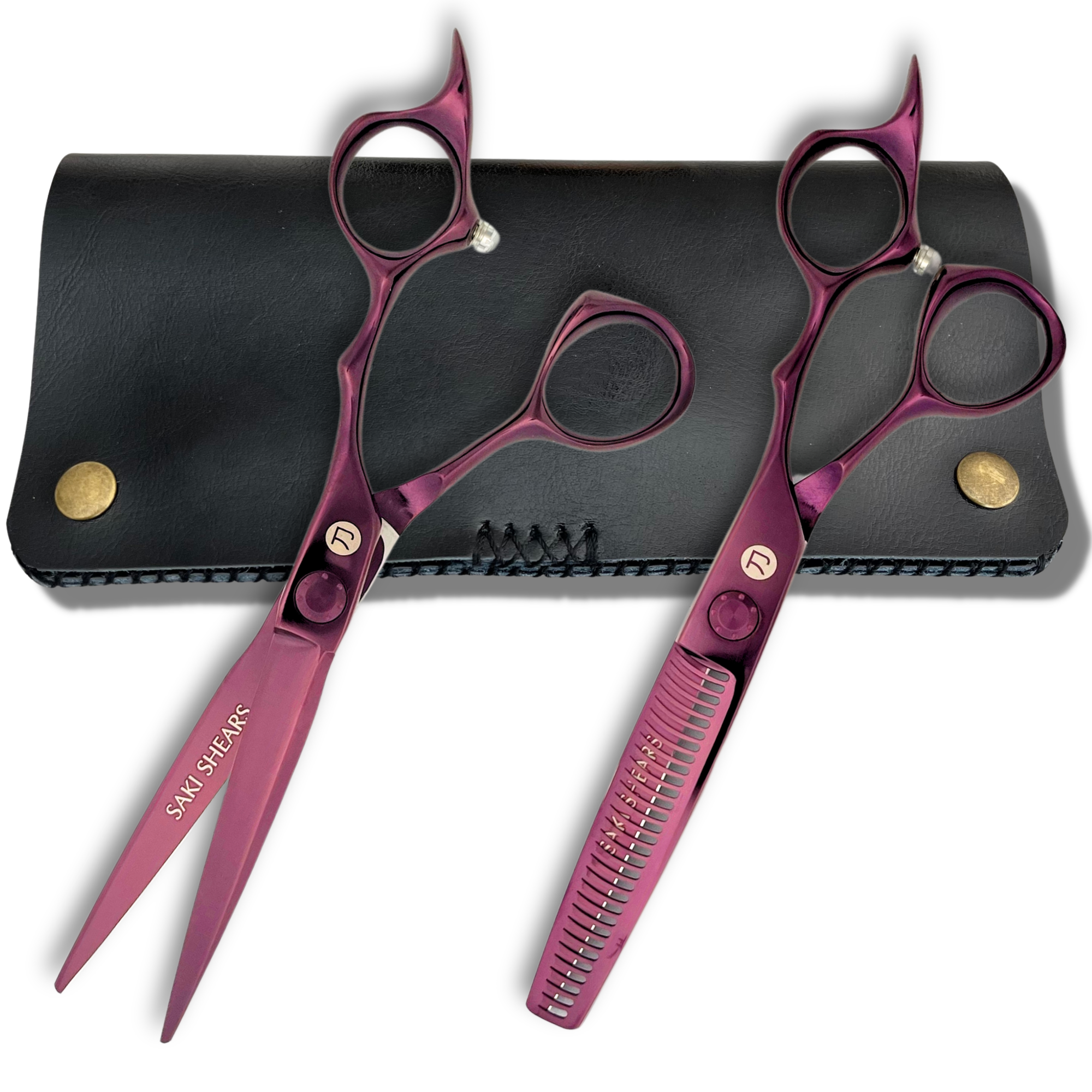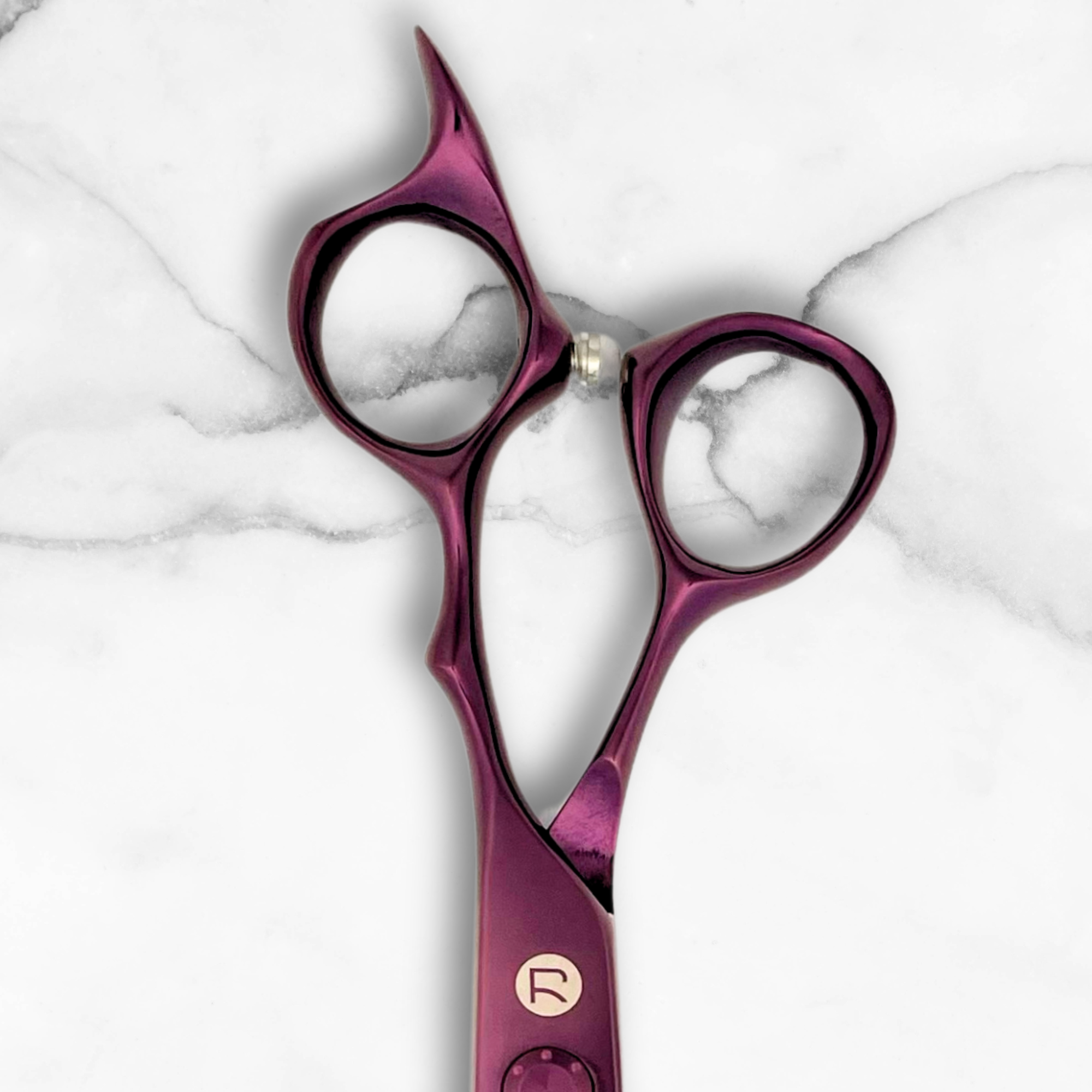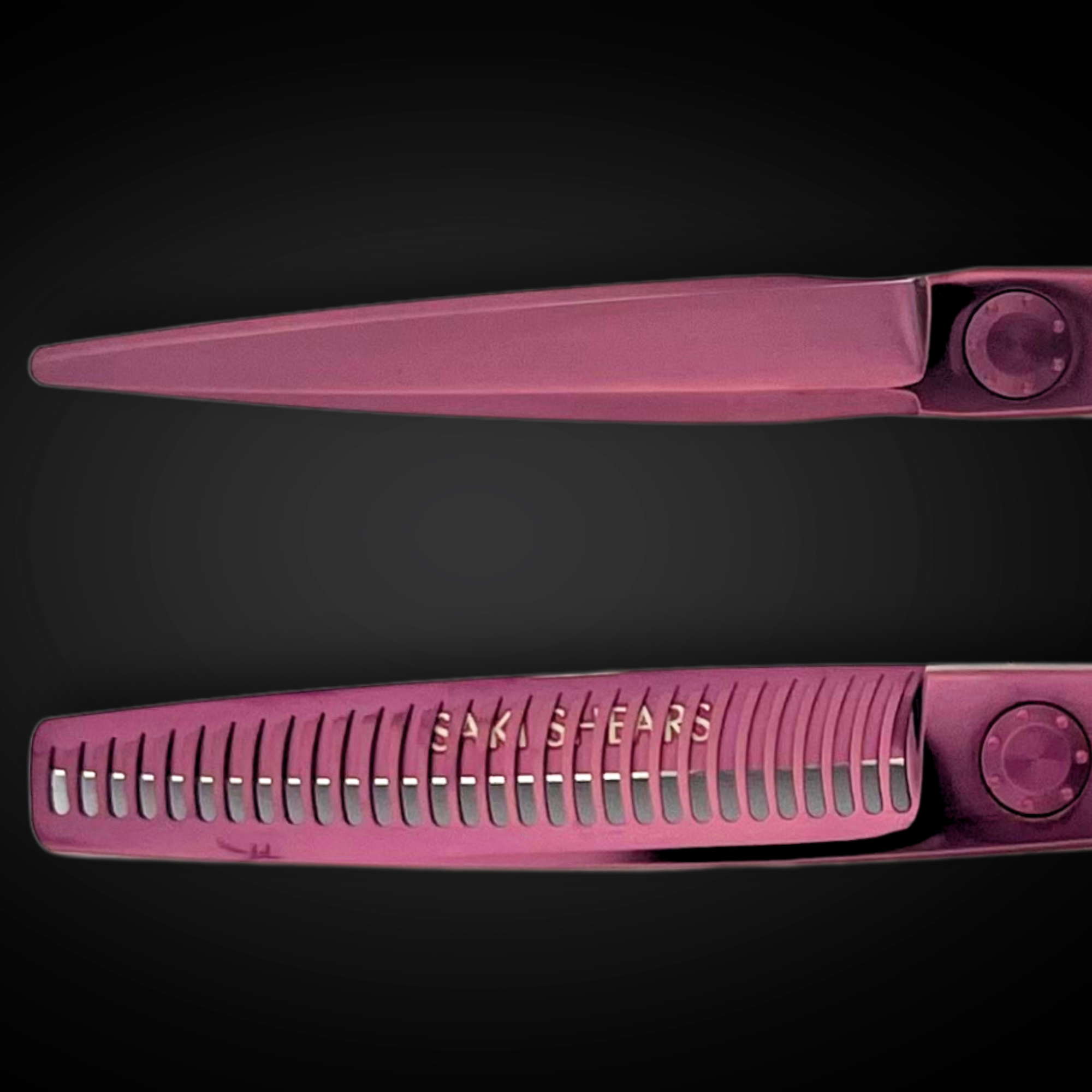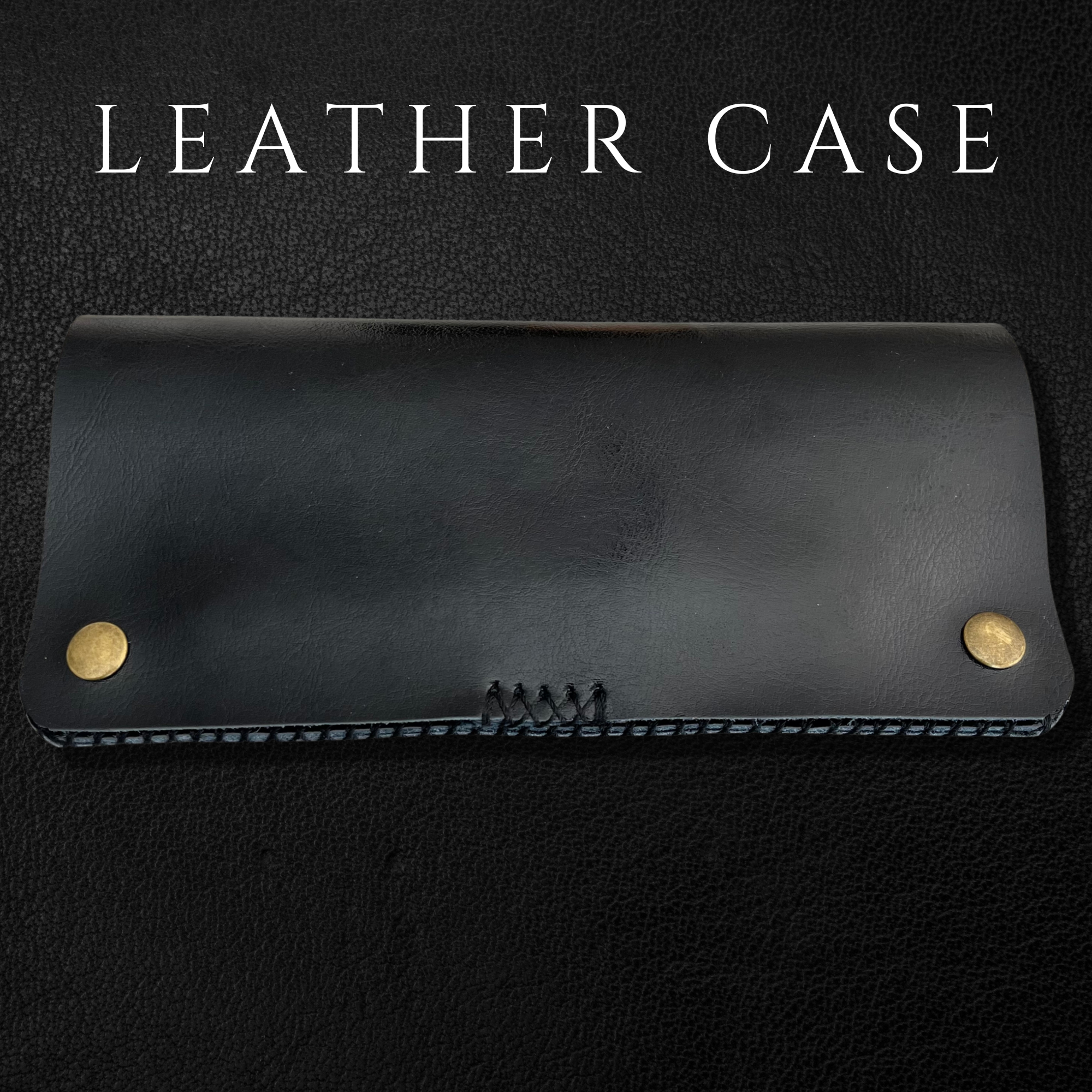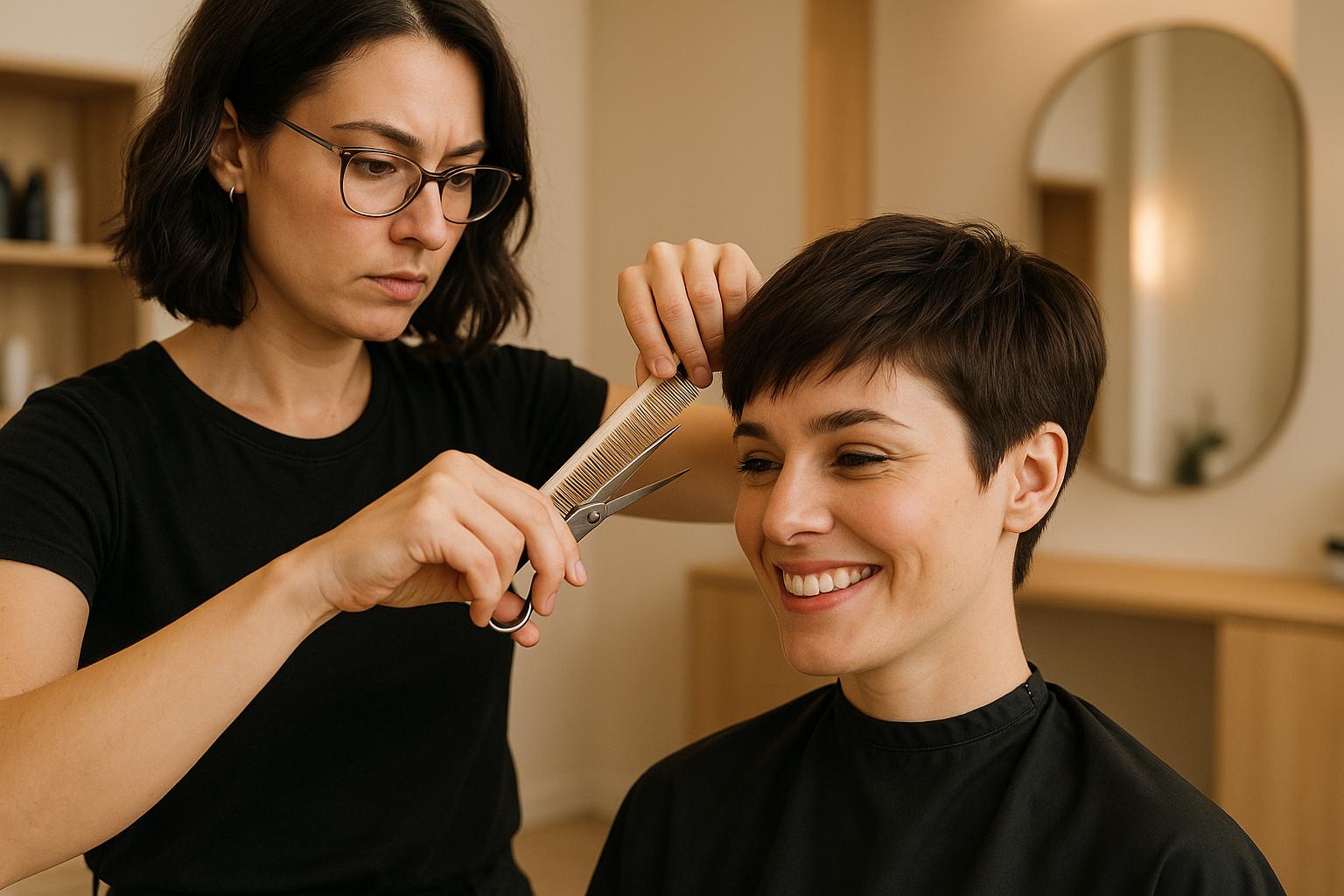How to Use Shears Without Damaging Blades
Using hair shears correctly can save you time, money, and frustration. Improper handling, poor maintenance, or using the wrong techniques can dull or damage your blades, leading to uneven cuts and costly repairs. Here’s what you need to know to keep your shears in excellent condition:
- Grip and handling: Use a relaxed yet firm grip, with your thumb in the smaller ring and your ring finger in the larger one. Avoid twisting your wrist or gripping too tightly to prevent blade misalignment or damage.
- Blade tension: Check and adjust tension regularly using simple tests (e.g., vertical drop test). Proper tension ensures smooth cuts and prevents unnecessary wear.
- Cutting techniques: Avoid forcing the shears through resistance. Cut smaller sections of hair and use steady, smooth motions to reduce strain on the blades.
- Daily care: Clean your shears after every use with appropriate tools and lubricate the pivot point weekly. Avoid harsh chemicals that can corrode the metal.
- Storage: Store shears in a dry, protective case to prevent nicks, rust, or accidental damage.
SCISSOR MAINTENANCE - How to clean, oil and tension barber & hairdressing shears to keep them sharp!
How to Handle Hair Shears Correctly
Handling your hair shears the right way isn’t just about comfort - it’s about protecting your tools and ensuring they perform at their best. Poor handling can lead to dull blades, misalignment, or even permanent damage. By focusing on your grip and wrist position, you can extend the life of your shears and achieve smooth, accurate cuts every time.
How to Grip Shears and Position Your Fingers
When holding your shears, place your thumb in the smaller ring and your ring finger in the larger one. This setup improves control and stability, as using your ring finger - rather than your index finger - offers better balance.
Your grip should be firm but relaxed. If you grip too tightly, you’ll create unnecessary tension that travels up your arm, which might cause the blades to bind or result in uneven cuts. On the flip side, holding them too loosely risks dropping the shears, which could chip or misalign the blades.
Let your index and middle fingers rest gently against the finger rest or tang. This helps distribute the weight evenly across your hand and gives you better control. Avoid hooking multiple fingers through the rings, as this disrupts balance and places uneven pressure on the pivot point, which can interfere with the shears’ performance.
How to Keep Your Wrist Aligned
Keeping your wrist neutral is key to protecting your shears. Avoid bending your wrist up, down, or to the sides. Misalignment changes the blade angle, leading to uneven wear and potential damage. Instead, focus on keeping your wrist straight and stable.
For better precision, keep your elbow close to your body and rely on movements from your shoulder and elbow to adjust cutting angles. If you find yourself needing to reach awkward positions, move your body or ask your client to tilt their head rather than twisting your wrist unnaturally.
Wrist rotation can also throw off the alignment of your shears, so it’s essential to keep your wrist steady and use your entire arm for adjustments.
Take breaks every 30-45 minutes to stretch and reset your form. Fatigue can lead to tighter grips or poor wrist positioning, which not only affects your cuts but also risks damaging your shears. If you notice discomfort or tension building, step away for a quick stretch.
For heavier shears, use a firmer grip with deliberate movements, while lighter shears require a gentler touch. Adjusting your grip based on the weight of your shears helps you maintain control and precision.
How to Prepare Your Shears Before Cutting
Getting your shears ready before cutting is crucial to avoid damage and achieve clean, precise cuts. This involves checking the tension and organizing your workspace properly.
How to Adjust Tension and Check Blade Alignment
Incorrect tension can lead to hair bending instead of cutting cleanly, put undue stress on the blades, and cause them to wear out faster.
The vertical drop test is a reliable way to check the tension. Hold your shears vertically with the tips pointing upward and open the blades fully. Let one blade drop naturally. Ideally, it should close halfway and stop around a 45° angle. If the blade slams shut, the tension is too loose. If it barely moves or stays open, it’s too tight.
For a more precise check, try the 30-degree angle test. Hold your shears at a 30° angle with the tip pointing up and to the left. Grip the bottom handle with one hand and lift the top handle until the blades open about 60°. Release the top handle to let it drop freely. If the tension is correct, the blade should close and stop just before fully closing, leaving a small 1/4-inch gap between the tips.
Signs that the tension needs adjustment include hair bending instead of cutting, wobbly blades, or noticeable wear near the blade tips. If the tension is too tight, you’ll feel resistance when closing the shears, which can lead to hand fatigue. On the other hand, tension that’s too loose can cause the blades to slam together, potentially damaging them over time.
To adjust the tension, locate the tension screw, typically found at the pivot point. Turn it in small quarter-turn increments - clockwise to tighten and counterclockwise to loosen. Small adjustments are key, as over-tightening can harm the pivot mechanism and permanently misalign the blades.
To check blade alignment, slowly close your shears and observe how the blades meet. The blades should come together evenly along their entire length without gaps or overlaps. Misaligned blades can cause uneven wear and inconsistent cuts, which can weaken the metal over time.
Proper tension and alignment are essential for smooth, precise cutting.
How to Section Hair for Better Cuts
Sectioning hair correctly can significantly reduce resistance during cutting. When hair is left unsectioned, it creates excess strain on your shears, dulling the blades and stressing the pivot point.
Start by dividing the hair into manageable sections. Working with thinner sections allows your shears to glide through the hair more easily, minimizing strain and protecting the edges. Use a comb to detangle each section and ensure the hair is evenly distributed. Uneven distribution can cause the blades to bind or skip, leading to irregular wear.
Keep consistent tension on each section. Holding the hair too tightly can stretch it, affecting the cut length, while holding it too loosely may cause the hair to shift and lead to uneven results. Position the sections at angles that allow you to maintain proper wrist alignment. Instead of twisting your shears into awkward positions, adjust the hair sections to protect both your technique and your tools.
For textured or curly hair, work with smaller sections and take extra care to detangle each one. The natural texture increases resistance, so smaller, well-prepared sections are easier to handle.
Proper sectioning not only makes cutting more efficient but also reduces buildup on the blades, preventing drag and unnecessary pressure that can dull the edges.
Cutting Methods That Protect Your Blades
The way you cut can make or break the longevity of your blades. Using the right techniques not only ensures cleaner results but also keeps your tools in top shape. On the flip side, poor methods can lead to nicks, dull edges, and unnecessary wear on your shears - turning a quality investment into an avoidable expense.
How to Avoid Twisting or Applying Excess Force
One of the quickest ways to damage your shears is by forcing them through resistance. If you feel the blades struggling, stop immediately and reassess the situation instead of pushing through.
"Never complete a cut if the section of hair offers resistance. This is one of the most important rules in caring for your shears, and it is also the most common reason for damage to hair scissors. Struggling through a cut means the shears being used are too light for the task, and forcing the blades to cut can severely damage edges. Cut smaller sections instead."
Resistance often signals that you're cutting too much hair at once or dealing with tangles. Breaking down large sections into smaller, manageable pieces reduces strain on your blades and makes the process smoother. Smaller sections also mean cleaner cuts with less effort.
Relax your grip while cutting. Holding the shears too tightly can create unnecessary tension, not only in your hands but also in your cutting motion. Your fingers should guide the shears naturally - no need for a white-knuckle hold.
Avoid twisting the shears to reach awkward angles. Instead, adjust your body position or the hair itself. Twisting puts uneven pressure on the pivot point, which can misalign the blades over time. If you need to cut at an angle, move yourself or the hair rather than forcing the tool into an unnatural position.
Pay attention to warning signs like hair bending instead of cutting cleanly, hand strain, or the need to "saw" through sections. These are clear indicators to slow down, reduce the size of your sections, or check if your blades need sharpening.
Once you've mastered safe handling, the next step is adopting cutting techniques that protect your tools while delivering professional results.
Which Cutting Techniques to Use
Careful handling is only half the equation - using the right cutting techniques is just as important. Different methods distribute pressure differently, and choosing the right one can help you achieve great results while keeping your blades in good condition.
For clean, sharp lines, blunt cutting is your go-to. Cutting at a 90-degree angle ensures pressure is evenly distributed across both blades. Smooth, steady cuts are key here - jerky or inconsistent motions can strain the metal and lead to uneven results.
Point cutting is perfect for softer, textured edges. By making small, precise cuts into the hair ends, you can create a natural, blended look. Hold your shears at a slight angle for this technique, and make sure your blades are sharp. Dull shears require more force, increasing the risk of damage.
When it comes to texturizing, position your shears at a 45-degree angle. This method is ideal for removing bulk and creating layers with a softer finish. The angled position helps distribute pressure evenly, reducing strain on the blades.
Above all, aim for smooth, confident motions. Avoid "hacking" at the hair, which not only stresses your tools but also leaves jagged, uneven ends. Practice makes perfect, so focus on fluidity to protect your blades and deliver polished results every time.
sbb-itb-3cc0078
Daily Care During Use
Keeping your shears in top shape requires consistent attention. Hair, styling products, and moisture can quickly accumulate, impacting both their performance and lifespan. By adopting a few simple daily habits, you can ensure your tools remain effective and ready to use.
How to Clean and Remove Hair Buildup
Clean your shears after each client and dedicate time for a thorough cleaning at the end of the day. Use cleaning products specifically designed for hair-cutting tools. These are gentle on the metal and effective at clearing buildup. Avoid household cleaners or dish soap, as they can strip protective coatings and lead to corrosion.
Whether you’re cutting wet or dry hair, regular cleaning is essential. Even small particles can disrupt blade alignment and affect performance.
For deeper cleaning, try this overnight method: apply shear oil to the pivot point with the blades set at a 45-degree angle, then leave it to work overnight. The next morning, open and close the blades repeatedly while holding the shears downward. This motion helps dislodge debris, which you can then wipe away with a cleaning cloth.
You might also consider using an alcohol wax-based lubricant instead of traditional oil. Unlike oil-based products, which can trap particles, alcohol wax-based lubricants are designed to remove dirt and debris. Apply a small amount to the pivot area with the blades slightly open, then open and close the shears to distribute the lubricant. Wipe away any excess with a soft cotton cloth or chamois.
When drying your shears, opt for materials like microfiber cloths, cotton cloths, or chamois. These won’t leave fibers behind or scratch the blades. Once cleaned and dried, inspect your shears to ensure they’re performing at their best. Simple, consistent care like this can greatly extend the life of your tools.
How to Inspect and Sanitize Blades
Daily inspection is essential for catching potential issues early. As you clean, check for nicks along the cutting edge, loose screws, or any roughness when opening and closing the blades. Pay special attention to the pivot point. If the blades feel sticky or catch during movement, it could indicate buildup that needs addressing - something the overnight oil method can help resolve.
Sanitizing your shears is just as important. Between clients, clean and sanitize the blades to prevent buildup of hair, products, and moisture. This step not only maintains performance but also ensures client safety by reducing the risk of cross-contamination.
Be cautious during sanitization. Avoid exposing your shears to sterilizing solutions, perm chemicals, or hair color products, as these substances can cause rust and corrosion. Stick to products made specifically for hair-cutting tools to protect your blades.
Keep an eye on how your shears perform during use. If cutting feels less smooth, or hair starts bending instead of being cut cleanly, it might be time for a more thorough cleaning or even professional sharpening. Addressing these signs early can prevent further damage.
Consistency is the key to maintaining your shears. Daily cleaning and inspection routines only take a few minutes but can make all the difference in preserving their precision and reliability over time. A little effort each day ensures your tools are always ready to deliver excellent results.
How to Store Shears at Day's End
Where and How to Store Your Shears
Once your shears are cleaned and sanitized, the final step is to store them properly. Place them in a protective case, pouch, or sheath to shield them from potential damage like nicks, dust, or accidental drops. Ensure the storage area is dry and maintains a stable temperature to avoid moisture and temperature swings, which can lead to metal expansion, contraction, or even corrosion. This careful storage routine helps keep your shears in excellent condition for longer use.
Conclusion: Main Points for Shear Care
Taking consistent care of your shears is essential for maintaining their precision and extending their lifespan. A few simple daily habits can go a long way in preventing blade damage and keeping your tools in top condition.
The foundation of shear care lies in proper handling. Always use your shears exclusively for cutting hair, avoid forcing the blades, and never drop them on hard surfaces. These steps help prevent unnecessary dulling and damage.
Daily maintenance plays a crucial role in keeping your shears performing at their best. After each client, wipe your shears clean with a microfiber cloth. Regularly check the tension and oil the pivot weekly to ensure smooth operation. Performing a quick tension test can catch any potential issues early.
Investing in high-quality shears, such as those crafted from Japanese steel by Saki Shears, enhances the benefits of diligent maintenance. These premium tools are designed for precision and durability. As Charles Harris from Saki Shears puts it:
"Maintaining hair shears is not just about ensuring their longevity; it's about preserving their cutting precision and reliability".
With features like ergonomic designs and lifetime warranties, shears from Saki Shears provide lasting performance while supporting your daily efforts.
To protect your investment, make it a habit to clean, lubricate, and test your shears regularly. Schedule professional sharpening every 6–12 months to keep them in peak condition. By sticking to these practices, you not only save money on repairs but also ensure your clients receive the precise, clean cuts they expect. Small, consistent efforts today lead to better results and longer-lasting tools tomorrow.
FAQs
How often should I check and adjust the tension on my shears, and what are the signs it’s needed?
To keep your shears in top shape, it's important to check their tension daily and make adjustments weekly - or whenever necessary, depending on how often you use them. Proper tension not only ensures smooth, precise cuts but also helps avoid unnecessary wear and tear.
How can you tell if your shears need an adjustment? Look out for these signs: the blades might feel too tight or too loose, hair may fold or slip instead of cutting cleanly, you could experience more hand strain, or you might notice visible wear near the tips. Taking care of these issues right away helps preserve the sharpness, performance, and lifespan of your shears.
By pairing regular maintenance with high-quality tools like Saki Shears, you can keep your shears in peak condition for years to come.
How can I clean and sanitize my hair shears to keep them in top condition?
To keep your hair shears in top shape, make it a habit to clean them immediately after each use. Use an alcohol-based spray or a damp cloth to wipe them down, and then dry them thoroughly with a lint-free cloth to avoid any moisture buildup. Protect the blades by applying a thin layer of shear oil, which helps guard against rust and corrosion. Be cautious about soaking them in disinfectants for extended periods, as this can harm the steel. For storage, choose a dry, breathable case, and regularly clear out any hair or debris from the pivot area using a small brush or compressed air.
What’s the best way to cut different hair textures without damaging my shears?
When it comes to keeping your shears in top shape and getting the best results, using the right technique for the specific hair texture is key. For fine hair, techniques like gentle point cutting or slide cutting with precision shears are ideal. On the other hand, for thick or curly hair, reach for thinning shears or try texturizing methods to reduce bulk without overworking the blades.
Always match the type of shears to the task at hand, and never force them through tough or resistant hair. This not only preserves the sharpness of your shears but also ensures they deliver consistently professional results over time.

